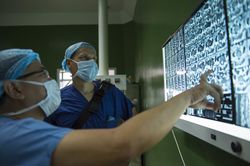Neurosurgeon
Neurosurgeon is the medical specialty concerned with the prevention, diagnosis, and surgical treatment related to the nervous system and peripheral nerves. It takes an average of 11 years to earn a degree in Neurology. Neurosurgery has been around thousands of years, but only within the last hundred years has neurosurgery made notable advancements. Around the 19th and early 20th centuries is when electrodes were placed on the brain to remove superficial tumors (type of bladder cancer found on the surface of the inside lining of the bladder). The average Neurosurgeon earns salary of $384,576 per year.
What is a Neurosurgeon
When people think of neurosurgeons, they think that they're just a physician who works with the brain. Although that’s true, neurosurgeons do much more than that. Neurosurgeons specialize in the diagnosis and surgical treatment of disorders of the central and peripheral nervous systems. In fact, 70 percent of a neurosurgeon’s time is devoted to the spine, treating back pain, neck pain, herniated discs, degenerative disc disease and even leg pain. Many people think that neurosurgeons also perform complex surgical procedures, which is true, but most neurosurgeons diagnose the patients and come up with a treatment plan like anti-inflammatory drugs for back pain, physical therapy, and other non-surgical means.
People also get confused between a neurosurgeon and an orthopedic surgeon because they both operate a lot on the spine. As mention already, neurosurgeons specialize exclusively on brain surgery, some on spine surgery, and some split their practice between the two. Orthopedic Surgeons specialize in the diagnosis and treatment of almost all bone and joint disorders, such as bone tumors, spinal disorders, and total joint replacement. This person said, “neurosurgeons handled spinal operations dealing with the discs and nerves, while orthopedic surgeons handled operations on the bony spine, such as spinal fusion.” [1]
Neurosurgeon's Degree and education
There are many different requirements that must be met before an individual can to legally practice neurosurgery. The fulfillment of these requirement could take about 11-12 years. One first needs to earn a Bachelor's degree. During the junior year of study for a Bachelor's one will need to take the Medical College Admission Test. This will help the medical schools to evaluate a candidate's training through a skills assessment. After receiving a bachelor degree one will attend medical school for four years. After medical school one must take an exam called, The United States Medical Licensing Examination (USMLE) to receive a Medical Licence.
Upon earning a medical licence, one must complete a one-year hospital internship, followed by a six to eight year neurosurgical residency. During the internship, surgeons will learn how to manage patients and will develop skills that will assist them in their future careers. While in neurosurgery residency the surgeons, will work alongside licensed surgeons learning skills and techniques essential to the field. After finishing an internship and neurosurgical residency, neurosurgeons can apply for licensing through their state's medical board by submitting an application and paying requisite fees, as well as submitting test scores and school transcripts. Even after becoming a license neurosurgeon, continuing education is required to renew their licensing and board certification. Neurosurgeons will attend classes and seminars held by medical schools and professional organizations in order to stay current on technologies and medical breakthroughs.[2]
Neurosurgery Procedures
Today, there are many forms of treatment for various conditions of the spine, brain, and peripheral nerves. Neurosurgeons usually prescribe physical therapy, nerve blocks, and sometimes medications, but when these treatment are ineffective, the neurosurgeon will give the option of surgery. There are many types of neurological surgery, but first there are preparations to be made before each surgery. A neurosurgeon may give his patient an Aspirin or other blood thinners several days before your surgery. You may not eat or drink anything, or take other medications in the morning of his surgery. [3]
Cervical (relating to the neck):
Anterior Cervical Discectomy and Fusion - is a common surgical procedure used to treat nerve root or spinal cord compression. Neurosurgeons will first decompress the spinal cord and nerve roots of the cervical spine in order to stabilize the corresponding vertebrae. This procedure is used when all else fails.
Anterior Corpectomy – is an operation used to remove a portion of the vertebra and the adjacent intervertebral discs for decompression of the cervical spinal cord and spinal nerves.
Cervial Laminectomy – is a procedure used to relieve pain caused by pressure on the spinal cord or nerves due to spinal stenosis (a narrowing of the bone channel occupied by the spinal nerves or the spinal cord) or ruptured discs.
Cervical Discectomy – is a surgical procedure performed to remove a herniated (a problem with one of the disks between vertebrae that stack up to make your spine) or degenerative disc in the cervical (neck) spine.
Anterior Cervical Disc Anthroplasty – is a procedure where an artificial disk is inserted to replace a herniated or degenerative disc via an anterior approach.
Posterior Cervical Laminectomy – may be used to treat cervical stenosis by removing the lamina (a thin layer, plate, or scale of sedimentary rock, organic tissue, or other material) to enable more room for the spinal cord.
Posterior Cervical Fusion – is performed to relieve the pain caused pressure on one or more nerve roots, or on the spinal cord. It involves the stabilization of two or more vertebrae by locking them together (fusing them). The fusion stops the vertebral motion and as a result, the pain is also stopped.
Thoracic (relating the middle section of the body):
Kyphoplasty – is a minimally invasive surgery used to repair spinal compression fractures.
Vertebroplasty – is a minimally invasive, non-surgical procedure that is designed to relieve the pain of compression fractures.
Lumbar (relating to the lower part of the back):
Lumbar Laminectomy – is a surgical procedure most often performed to treat leg pain related to herniated discs, spinal stenosis, and other related conditions.
Posterior Lumbar Interbody Fusion – is a surgical technique that is performed in patients with refractory mechanical low back and radicular pain associated with spondylolisthesis, degenerative disc disease, and recurrent disc herniation.
Translateral Lumbar Interbody Fusion – is a less invasive procedure to fuse the spine segment from one side. (MicroLumbar Discectomy – is an extremely conservative microsurgical procedure for the treatment of a herniated lumbar disc and pinched nerves.)
Lumbar Peritoneal Shunt – is a procedure used to divert spinal fluid from the lumbar region to the abdomen for treatment of hydrocephalus or pseudo tumor.
General Spinal Procedures:
Laminectomy for excision of mass or lesion – is a surgical procedure which enters the spinal canal in order to remove a mass or lesion.
Open Reduction and Internal Fixation – is a surgical procedure used to align the spine under direct and X-Ray examination. [4]
Video
A neurosurgeon talks about his job
References
- ↑ Author Unknown Neurosurgery Highland Hospital. Accessed on March 18, 2017
- ↑ How to Become a Neurosurgeon: Education and Career Roadmap Study.com. Web. accessed on March 19, 2017. Author Unknown.
- ↑ Author Unknown. Neurosurgery Procedures Nervous system disease . Web. accessed on March 19, 2017
- ↑ Author Unknown. List of Procedures Costal Neurological Institution. Web. accessed on March 19, 2017
| ||||||||||||||||||||




